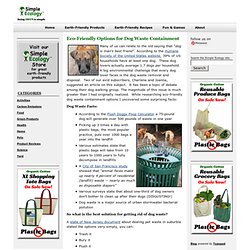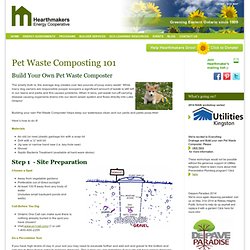

Simple Ecology: Eco-Friendly Options for Dog Waste Containment. Many of us can relate to the old saying that “dog is man’s best friend”.

According to the Humane Society of the United States website, 39% of US households have at least one dog. These dog lovers actually average 1.7 dogs per household. A big environmental challenge that every dog lover faces is the dog waste removal and disposal. Two of our avid subscribers, Charlene and Joanna, suggested an article on this subject. It has been a topic of debate among their dog walking group. Dog Waste Facts: According to the Flush Doggy Poop Calculator a 75-pound dog will generate over 500 pounds of waste in one year So what is the best solution for getting rid of dog waste?
A state of New Jersey document about dealing pet waste in suburbia stated the options very simply, you can: Trash itBury itFlush it. Composting Dog Waste. Build a Pet Waste Composter Using a Garbage Can. Composting Dog Waste. My boyfriend had argued for a rottweiler.

I lobbied for something that weighed a more manageable 30 pounds and didn’t look like it snacked on children. (Rotties can be very sweet, I know, but I also wasn’t into the uncontrollable drooling.) We compromised and found an adorable, 45-pound mutt at a local shelter. Honey has a yellow lab body with a pit bull head that looks like it was screwed on by a mad scientist. Actually, she is totally adorable and not at all mutant-like.
I started getting the newspaper delivered around the same time we got Honey, and because our paperboy insisted on double bagging on even the driest of days, our porch was overrun with yellow plastic sleeves. I was taking a natural product that would eventually degrade on its own and encasing it in plastic. Turns out there are a few commercial composters out there, like the Doogie Dooley, but since I feel my $89.95 could be better spent on squeaky toys and treats, I decided to make one myself for less than ten bucks. Hearthmakers Energy Cooperative. Build Your Own Pet Waste Composter The smelly truth is: the average dog creates over two pounds of poop every week!

While many dog owners are responsible pooper scoopers a significant amount of waste is still left in our lawns and parks and this causes problems. When it rains, pet waste run-off carrying disease causing organisms drains into our storm sewer system and flows directly into Lake Ontario! Building your own Pet Waste Composter helps keep our waterways clean and our yards and parks poop-free! Here’s how to do it! Materials An old (or new) plastic garbage bin with a snap lidDrill with a ¼” drill bitJig saw or narrow hand saw (i.e. key-hole saw)ShovelSeptic Bacteria Treatment (available at hard-ware stores) Step 1 - Site Preparation Choose a Spot Away from vegetable gardensPreferable out of direct sunlight At least 100 ft away from any body of water (includes small backyard ponds and wells) Call Before You Dig Do a Percolation Test Assess your results: Step 2: Prepare Your Bin Drill Holes.
Compost: the Safest Dog Waste Disposal System. By Linda Foss Compost: the Safest Dog Waste Disposal System Dog waste disposal poses a dilemma to the environmentally friendly pet owner.

Leaving the waste on the ground is hazardous, as it may carry E. coli, salmonella, or giardia, and the rain can wash it into rivers, streams, and oceans. Beaches and rivers have been closed to the public due to such contamination. So we need to pick it up. While there are dog waste composting systems for sale, making a composter yourself is simple and inexpensive. To prepare the can, cut out the bottom and drill holes in the sides. Start off decomposition by adding a liter of water and some septic tank enzymes. Cautionary Notes on Dog Waste Disposal Locate the composter away from your edible plants, and don’t use the composted waste on them. If you live in a cold climate or an area with high water tables or heavy clay soils, you may need to do additional research. Add your comments.